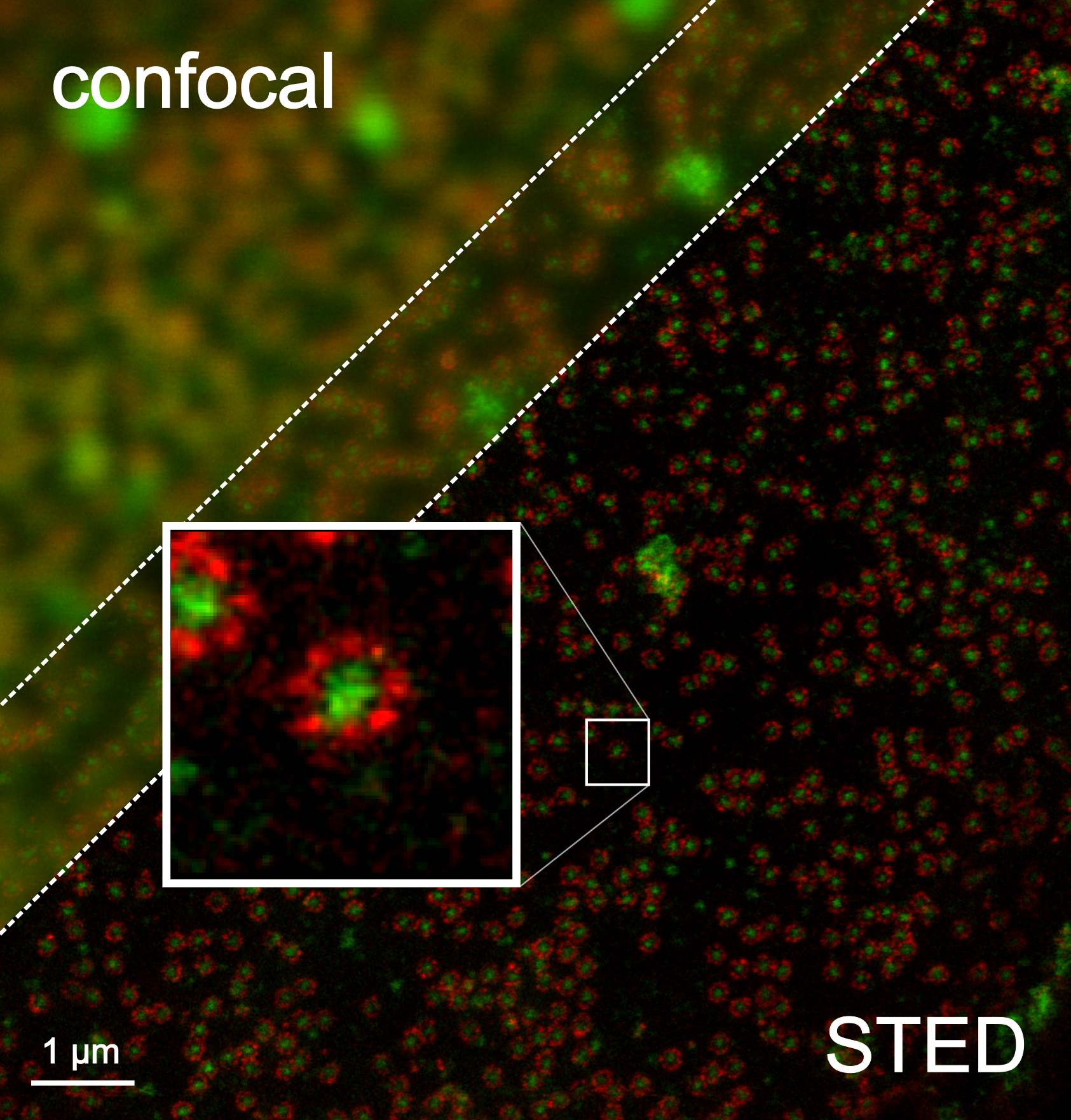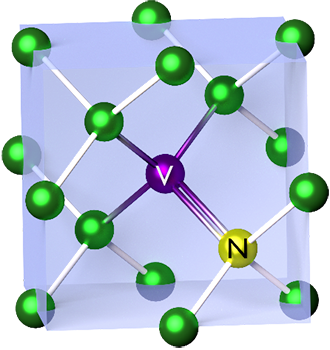|
GSD Microscopy
Ground state depletion microscopy (GSD Microscopy) is an implementation of the RESOLFT concept. The method was proposed in 1995 and experimentally demonstrated in 2007. It is the second concept to overcome the diffraction barrier in far-field optical microscopy published by Stefan Hell. Using nitrogen-vacancy centers in diamonds a resolution of up to 7.8 nm was achieved in 2009. This is far below the diffraction limit (~200 nm). Principle In GSD microscopy, fluorescent markers are used. In one condition, the marker can freely be excited from ground state and returns spontaneously via emission of a fluorescence photon. However, if light of appropriate wavelength is additionally applied the dye can be excited to a long-lived dark state, i.e. a state where no fluorescence occurs. As long as the molecule is in the long-lived dark state (e.g. a triplet state In quantum mechanics, a triplet is a quantum state of a system with a spin of quantum number =1, such that there a ... [...More Info...] [...Related Items...] OR: [Wikipedia] [Google] [Baidu] |
RESOLFT
RESOLFT, an acronym for REversible Saturable OpticaL Fluorescence Transitions, denotes a group of optical fluorescence microscopy techniques with very high resolution. Using standard far field visible light optics a resolution far below the diffraction limit down to molecular scales can be obtained. With conventional microscopy techniques, it is not possible to distinguish features that are located at distances less than about half the wavelength used (i.e. about 200 nm for visible light). This diffraction limit is based on the wave nature of light. In conventional microscopes the limit is determined by the used wavelength and the numerical aperture of the optical system. The RESOLFT concept surmounts this limit by temporarily switching the molecules to a state in which they cannot send a (fluorescence-) signal upon illumination. This concept is different from for example electron microscopy where instead the used wavelength is much smaller. Working principle RESOLFT micro ... [...More Info...] [...Related Items...] OR: [Wikipedia] [Google] [Baidu] |
Stefan Hell
Stefan Walter Hell HonFRMS (: born 23 December 1962) is a Romanian-German physicist and one of the directors of the Max Planck Institute for Biophysical Chemistry in Göttingen, Germany. He received the Nobel Prize in Chemistry in 2014 "for the development of super-resolved fluorescence microscopy", together with Eric Betzig and William Moerner. Life Born into a Roman Catholic Banat Swabian family in Arad, Romania, he grew up at his parents' home in nearby Sântana. Hell attended primary school there between 1969 and 1977. Andreea Pocotila"Fizicianul premiat cu Nobelul pentru chimie vorbește românește și ține legătura cu mediul științific din țara noastră" ''România Liberă'', October 8, 2014 Subsequently, he attended one year of secondary education at the Nikolaus Lenau High School in Timișoara before leaving with his parents to West Germany in 1978. His father was an engineer and his mother a teacher; the family settled in Ludwigshafen after emigrating. He ... [...More Info...] [...Related Items...] OR: [Wikipedia] [Google] [Baidu] |
Nitrogen-vacancy Center
The nitrogen-vacancy center (N-V center or NV center) is one of numerous point defects in diamond. Its most explored and useful property is its photoluminescence, which allows observers to read out its spin-state. The NV center's electron spin, localized at atomic scales, can be manipulated at room temperature by external factors such as magnetic, or electric fields, microwave radiation, or light, resulting in sharp resonances in the intensity of the photoluminescence. These resonances can be explained in terms of electron spin related phenomena such as quantum entanglement, spin–orbit interaction and Rabi oscillations, and analysed using advanced quantum optics theory. An individual NV center can be used as a basic unit for a quantum computer, a qubit, and used for quantum cryptography. Further potential applications in novel fields of electronics and sensing include spintronics, masers, and quantum sensors. If the charge is not specified the term "NV center" refers to the negativ ... [...More Info...] [...Related Items...] OR: [Wikipedia] [Google] [Baidu] |
Diffraction Limit
The resolution of an optical imaging system a microscope, telescope, or camera can be limited by factors such as imperfections in the lenses or misalignment. However, there is a principal limit to the resolution of any optical system, due to the physics of diffraction. An optical system with resolution performance at the instrument's theoretical limit is said to be diffraction-limited. The diffraction-limited angular resolution of a telescopic instrument is inversely proportional to the wavelength of the light being observed, and proportional to the diameter of its objective's entrance aperture. For telescopes with circular apertures, the size of the smallest feature in an image that is diffraction limited is the size of the Airy disk. As one decreases the size of the aperture of a telescopic lens, diffraction proportionately increases. At small apertures, such as f/22, most modern lenses are limited only by diffraction and not by aberrations or other imperfections in the co ... [...More Info...] [...Related Items...] OR: [Wikipedia] [Google] [Baidu] |
Triplet State
In quantum mechanics, a triplet is a quantum state of a system with a spin of quantum number =1, such that there are three allowed values of the spin component, = −1, 0, and +1. Spin, in the context of quantum mechanics, is not a mechanical rotation but a more abstract concept that characterizes a particle's intrinsic angular momentum. It is particularly important for systems at atomic length scales, such as individual atoms, protons, or electrons. Almost all molecules encountered in daily life exist in a singlet state, but molecular oxygen is an exception. At room temperature, O2 exists in a triplet state, which can only undergo a chemical reaction by making the forbidden transition into a singlet state. This makes it kinetically nonreactive despite being thermodynamically one of the strongest oxidants. Photochemical or thermal activation can bring it into the singlet state, which makes it kinetically as well as thermodynamically a very strong oxidant. __TOC__ Two spin ... [...More Info...] [...Related Items...] OR: [Wikipedia] [Google] [Baidu] |
STED Microscopy
Stimulated emission depletion (STED) microscopy is one of the techniques that make up super-resolution microscopy. It creates super-resolution images by the selective deactivation of fluorophores, minimizing the area of illumination at the focal point, and thus enhancing the achievable resolution for a given system. It was developed by Stefan W. Hell and Jan Wichmann in 1994, and was first experimentally demonstrated by Hell and Thomas Klar in 1999. Hell was awarded the Nobel Prize in Chemistry in 2014 for its development. In 1986, V.A. Okhonin (Institute of Biophysics, USSR Academy of Sciences, Siberian Branch, Krasnoyarsk) had patented the STED idea. This patent was unknown to Hell and Wichmann in 1994. STED microscopy is one of several types of super resolution microscopy techniques that have recently been developed to bypass the diffraction limit of light microscopy to increase resolution. STED is a deterministic functional technique that exploits the non-linear response of ... [...More Info...] [...Related Items...] OR: [Wikipedia] [Google] [Baidu] |


